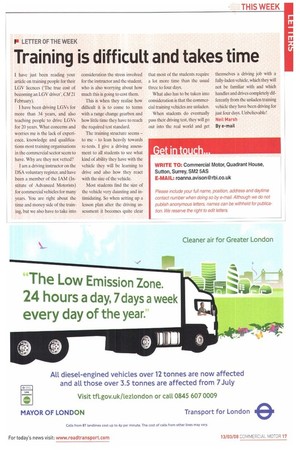P LETTER OF THE WEEK
Page 17

If you've noticed an error in this article please click here to report it so we can fix it.
Training is difficult and takes time
I have just been reading your article on training people for their LGV licences (`The true cost of becoming an LGV driver', CM 21 February).
I have been driving LGVs for more than 34 years, and also teaching people to drive LGVs for 20 years. What concerns and worries me is the lack of experience, knowledge and qualifications most training organisations in the commercial sector seem to have. Why are they not vetted?
I am a driving instructor on the DSA voluntary register, and have been a member of the IAM (Institute of Advanced Motorists) for commercial vehicles for many years. You are right about the time and money side of the training, but we also have to take into consideration the stress involved for the instructor and the student, who is also worrying about how much this is going to cost them.
This is when they realise how difficult it is to come to terms with a range change gearbox and how little time they have to reach the required test standard.
The training structure seems — to me — to lean heavily towards re-tests. I give a driving assessment to all students to see what kind of ability they have with the vehicle they will be learning to drive and also how they react with the size of the vehicle.
Most students find the size of the vehicle very daunting and intimidating. So when setting up a lesson plan after the driving assessment it becomes quite clear that most of the students require a lot more time than the usual three to four days.
What also has to be taken into consideration is that the commercial training vehicles are unladen.
When students do eventually pass their driving test, they will go out into the real world and get themselves a driving job with a fully-laden vehicle, which they will not be familiar with and which handles and drives completely differently from the unladen training vehicle they have been driving for just four days. Unbelievable!
Neil Marsh By e-mail








































































































































































